Scottish Economic Statistics 2008
This is the ninth edition of the annual publication Scottish Economic Statistics, which is produced by statisticians in the Scottish Government.
A2 Low pay and in-work poverty in Scotland
Tom Spencer, Scottish Government
In 2006-07 seventeen per cent of the Scottish population (840 thousand people) lived in relative poverty before housing costs. One third of these people (33 per cent) were in families containing working members whose wages were not enough to lift the family out of poverty. The number of people in in-work poverty has been a persistent problem in Scotland and has not changed dramatically over the last ten years. Despite this, three quarters of low-paid workers are not poor. This statement may seem slightly contradictory at first. How is it possible, if such a high proportion of poor people are in working families, that the majority of low-paid workers escape poverty?
The 280 thousand people in working poverty are members of those households which are in poverty despite the fact that one, or more, members of the household are working. The income from these workers is not enough to raise the household income above the poverty line. This group therefore contains many non-workers including children and non-working partners of these workers.
There are 2.2 million people in work in Scotland and estimates from the Family Resources Survey suggest that up to thirty per cent of these are low paid. These are workers receiving low hourly pay who are living in not-in-poverty households. This means that income from sources other than their basic salary, perhaps from second jobs, over-time, extra hours, benefits or the wages of other household members, lifts the household income above the poverty line. Who are these people and how do they escape poverty? What contribution to their income is made by the state and to what extent do they rely on the income of other household members? What are the factors which make workers more likely to fall below the poverty line? These are the questions which this article will discuss.
Sources of income for low-paid workers
In examining how low-paid workers escape poverty we are looking at two over-lapping groups which workers can fall into: those in low paid work and those whose households are in relative poverty. The relationships between these groups and the proportion of the workforce falling into each one are presented in Chart A2.1 below.
Chart A2.1: Proportion of workers that are low paid and in poverty: 2006-07 1
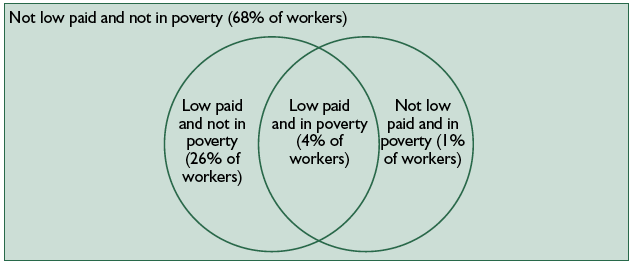
Source: DWP Family Resources Survey, Households Below Average Income dataset
Chart A2.2 examines the sources of household income for the 2.2 million workers in Scotland according to which of these groups they belong. The wages of low paid workers who escape poverty make up a much lower proportion of their household income than the wages of workers in other groups. Only one quarter of the household income for these workers comes from their wages compared to more than half for workers in the largest group: 'not low paid and not in poverty'.
Chart A2.2: Sources of household income for workers by low pay and relative poverty (before housing costs)
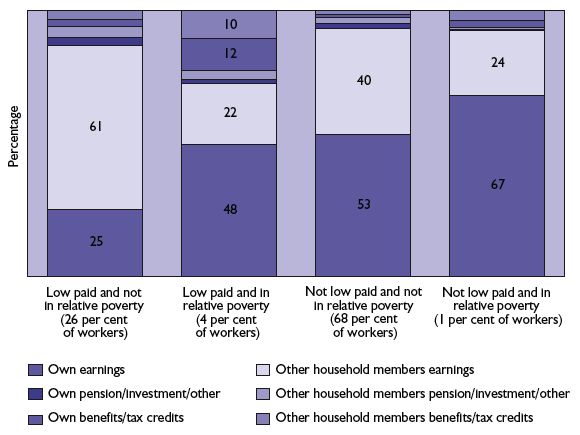
Source: DWP Family Resources Survey, Households Below Average Income dataset
Comparing the household incomes for the groups of low-paid workers who do and do not escape poverty the difference is striking. The earnings of workers that do not escape poverty make up almost half of their total household income with only a twenty-two per cent contribution from the wages of other household members. The remaining quarter of their income comes mainly from benefit payments made to them or other household members.
For low-paid workers who are not in poverty sixty-one per cent of household income comes from the wages of other household members. Less than fifteen per cent comes from benefit, pension and investment income. Income from other household members clearly plays a much larger part in bringing low-paid workers out of poverty than income from state benefits or pensions.
Although they only make up four per cent of the workforce, low-paid workers who are in poverty are much more dependent on their own incomes and state benefits than those who escape poverty.
Definitions used in this article Equivalised net disposable income: 'Equivalised' income is used to allow comparisons of living standards between different household types. Income is adjusted to take into account variations in the size and composition of the household. This adjustment reflects the fact that a family of several people requires a higher income than a single person in order for both households to enjoy a comparable standard of living. Relative poverty: This article defines families or households as being in poverty if their equivalised household income before housing costs is below sixty per cent of the UK median equivalised household income before housing costs for that year. This is a common measure of relative poverty and is in line with UK and Scottish Government, as well as international, statistics. Relative poverty is a measure of how well the incomes of the poorest in society are keeping up with growth in the wider economy. In 2006-07 the relative poverty threshold for a couple with two children was £332 per week. Absolute poverty: Individuals living in households whose equivalised income is below sixty per cent of the inflation adjusted median income from 1998-99. This is a measure of whether those in the lowest income households are seeing their incomes rise in real terms. Low-pay: A worker is defined as being low-paid if their hourly wage is below sixty per cent of the 2006 UK median hourly wage, £11.03 per hour. This produces a low pay threshold of £6.62 per hour. If workers have more than one job, they are defined as low paid if their highest hourly wage is below the low pay threshold. |
Family structure
One possible interpretation of Chart A2.2 would be that family structure plays an important role in bringing low-paid people out of poverty. If contributions from other household members make up sixty-one per cent of household income for those low-paid workers that escape poverty, perhaps many of those that do not escape live alone and so are unable to benefit from other incomes? A closer examination of the data however, reveals that the situation is more complex than this. Chart A2.3 shows that fifty-six per cent of low-paid workers that escape poverty are married or cohabiting compared with fifty per cent of those that do not. This is a slight difference and is probably not dramatic enough to explain the differences in Chart A2.2.
Chart A2.3 shows that higher paid workers are more likely to be married or cohabiting than lower paid workers regardless of whether they are in poverty. This is perhaps unsurprising as wages tend to increase with age and so lower paid workers are likely to be younger and to have had less time to find partners and settle down.
Chart A2.3: Marital status of worker by low pay and relative poverty (before housing costs) 2006-07
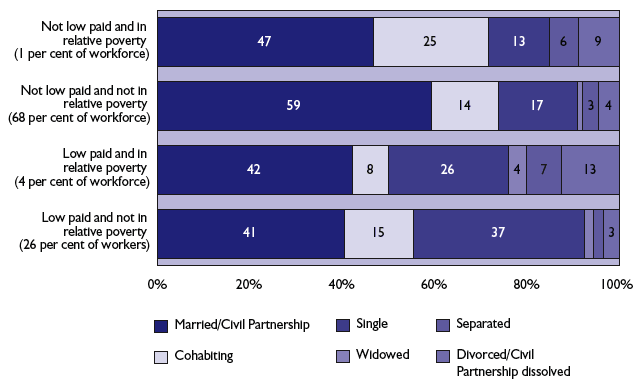
Source: DWP Family Resources Survey, Households Below Average Income dataset
One notable difference between the two groups of low-paid workers is that the proportion of 'widowed, separated or divorced' people is around three times higher among those in poverty (twenty-four per cent) than those outside poverty (seven per cent). This supports the theory that, after a relationship ends, the lower income partner in a relationship will often fall into poverty as they can no longer benefit from the income of the higher earner. 2
One area in which family structure has a clear impact on a workers ability to avoid poverty is number of children. As well as 'extra mouths to feed' workers with children may have more limited job opportunities than those without, as their caring responsibilities reduce the distance they can travel and the number of hours they can work. Chart A2.4 below shows a clear pattern which suggests that the workers which most successfully avoid poverty are more likely to have fewer children.
Chart A2.4: Number of children of worker by low pay and relative poverty (before housing costs) 2006-07
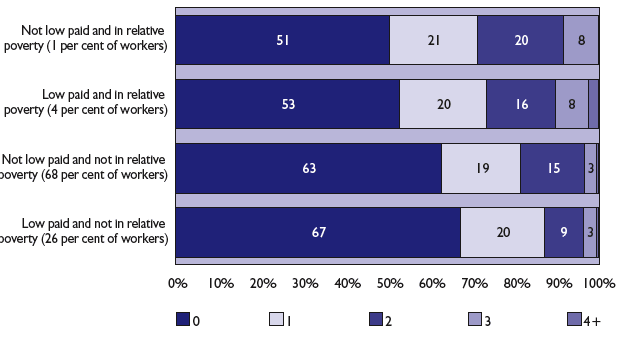
Source: DWP Family Resources Survey, Households Below Average Income dataset
Half of workers who are in poverty despite not being low-paid have children. For low-paid workers who escape poverty this figure is under one third. Only twelve per cent of low-paid workers who escape poverty have more than one child.
Economic status of family
Although marital status does not differ dramatically between poor and non-poor workers there are differences in the working patterns across families in these groups. Chart A2.5 breaks down some of these trends and shows that the proportion of workers from families with no full-time workers is higher among those in relative poverty. If workers' families do contain a full- time earner then trends differ according to the working pattern of the second partner. Full- time workers from couples where the other partner is not working are over-represented among poor workers, especially among those that are in relative poverty despite not being low-paid. Workers from couples with one full-time and one part-time worker are over-represented among the non-poor workers.
Chart A2.5: Economic status of worker's family by low pay and relative poverty (before housing costs) 2006-07
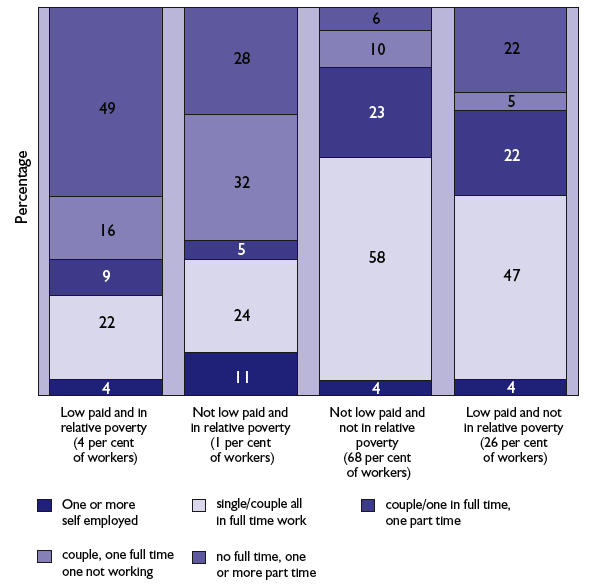
Source: DWP Family Resources Survey, Households Below Average Income dataset
Part-time workers are particularly at risk of low income poverty because, as well as working fewer hours, they tend to receive a lower hourly wage than full-time workers. Figures from the Annual Survey of Hours and Earnings suggest that in 2007 forty-four per cent of part-time jobs paid less than £6.80 3 per hour compared with fourteen per cent of full-time jobs. There are actually more low-paid part-time jobs in Scotland than low-paid full-time jobs despite the fact that almost three quarters of jobs are full-time. Taking this into account, it is unsurprising that the proportion of workers in families with either no full-time workers, or headed by a couple with one partner working full-time and the other not working, is higher among those in poverty. The difference is striking however, over sixty per cent of workers in poverty come from these types of families compared with twenty-six per cent of low paid workers that escape poverty and sixteen per cent of those in the 'not low paid and not in poverty' group.
This suggests that number of hours worked by all family members, as well as hourly wage, are important in bringing people out of poverty. Almost half of low-paid workers that escape poverty are in families where every adult is working full-time, only one fifth of low paid workers in poverty are in this type of family. For many couples of course, particularly those with caring responsibilities, full-time jobs for both partners may not be an option.
Conclusion
The relationships between low-pay, hours worked, family structure and economic status and in-work poverty are more complex than may be expected. It may surprise some people for example, that the majority of low paid workers are not in relative poverty. Income from other household members plays a crucial part in this, as do family structure and the number of hours worked by both partners.
It is certainly the case however, that for many low paid workers escaping poverty is not easy and income from part-time work or from only one worker is not sufficient to raise the family income above the poverty line. This article has highlighted several factors which put workers at greater risk of poverty, among these are part-time work, having children and being widowed, divorced or separated. Working poverty has been a persistent problem in Scotland and the UK and remains a challenging issue for government and wider society to tackle.
There is a problem
Thanks for your feedback